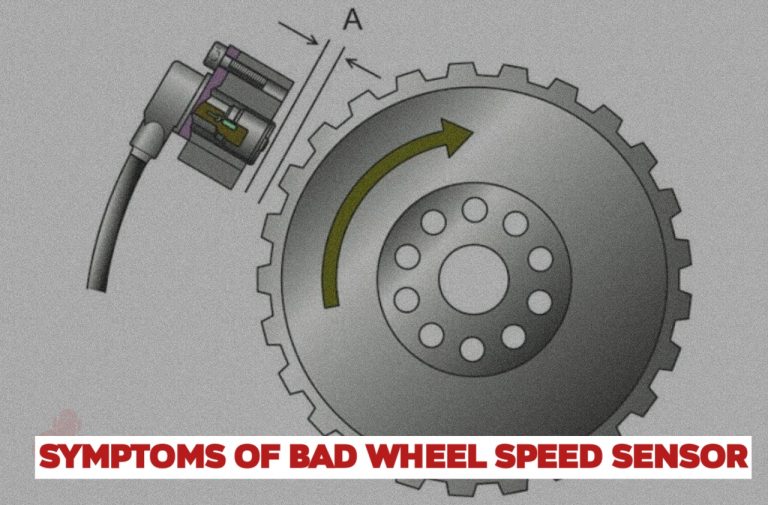If you’re running an automatic transmission, a defect in your wheel speed sensor will tell on the efficiency of your car.
The primary function of the wheel speed sensor is to relay the wheel’s rotational speed to the PCM, which balances the data and forwards it to components such as the speedometer, ABS module, and other transmission systems.
Once the wheel speed sensor goes bad, the PCM will no longer be able to get accurate data that’ll help it reduce the car speed in the case of emergency, thereby turning off features such as the anti-lock brakes.
Ignited ABS warning light, incorrect speedometer readings, vibrating brake pedals, and disabled traction and stability control are other lousy wheel speed sensor symptoms.
Without wasting much time, let’s learn about wheel speed sensors and what happens when a Wheel Speed Sensor goes Bad.
What is a Wheel Speed Sensor?
The wheel speed sensors are an essential component of the car’s anti-braking system, and their primary function is to monitor the movement of the front and rear wheels and make sure all four wheels are running at the same speed with the aid of the ABS sensor.
One speed sensor, the passive sensor, is responsible for relaying analog signals to the Anti-Braking system. In contrast, the Active sensor receives and records the calls using a magnetic pulse sensor.
The active sensors are more rigid and can resist electromagnetic interference; they can also work in extreme weather conditions and decipher the direction of the wheel spinning.
Continue reading to review five symptoms of a Bad wheel speed sensor.
Symptoms of a Bad Wheel Speed Sensor
Explained below are the symptoms that often accompany a Bad wheel speed sensor.
1. ABS Warning Light ignites
The speed sensors gather information about the car’s speed with the help of anti-braking sensors from the rotation of the four wheels.
The Anti-Braking system relays this information to the power control module, which checks and balances it.
If the PCM can’t balance the input and output data the Anti-Braking system gives, it’ll turn on the ABS warning light.
The ABS sends the wrong data because of a Bad wheel speed sensor.
This could also mean the sensors are clogged with dirt or mud, disconnected, or worn out.
You can take your vehicle to an auto repair shop for inspection since other issues cause the ABS warning light to come on.
2. Incorrect Speedometer Readings
The speed sensor helps the PCM to help the speedometer provide accurate readings.
You’ll either notice your speedometer at 0MPH or reading abnormally high.
3. Vibrating Brake Pedals
Since the function of the wheel speed sensor is to make sure the four wheels are running at the same speed, it helps create balance when the brake pedal is compressed.
However, if your wheel speed sensor goes wrong and the PCM cannot get accurate data, it’ll assume your tire is sliding without control.
This will result in a vibrating effect when the brake is applied.
4. Anti-lock Brakes Disabled
The anti-braking system helps driver engage their brakes in emergencies. Once the wheel speed sensor goes wrong, they’re usually the first to be disabled by the system.
If the driver applies brakes with the anti-lock brakes disabled, it’ll trigger the wheels to kick and cause skidding.
5. Traction & Stability Control stops working
Traction and stability control helps the driver maintain stability during emergency steering maneuvers.
This works well when plighting slippery roads by reducing the effect of friction on the tires.
If the traction and stability controls stop working due to a wheel speed sensor defect, driving through rough road parts will be hazardous.
Reasons Why Wheel Speed Sensors Go Bad
Listed below are the main reasons why wheel speed sensors become faulty.
- Accumulating dirt, debris, or mud will block the sensors’ ability to send signals.
- Internal sensor Failure
- Damaged sensor tip
- Excess impact of heat
- Different tire sizes will cause the tires to rotate at different speeds.
Can you drive with a bad-wheel speed sensor?
Yes, but it isn’t advisable for your safety and other road users.
Since a Bad wheel speed sensor makes it hard for the PCM to detect your car’s speed, it will likely lead to skidding and increased brake and engine power.
As an Amazon Service LLC Program Associate, V. Auto Basics earns from qualifying purchases. See Our Affiliate disclaimer.
